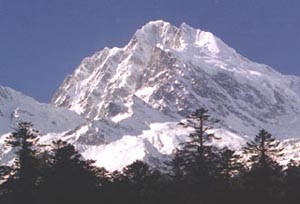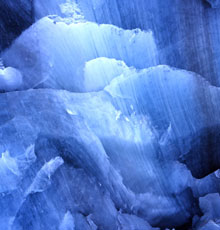
China's glaciers make up nearly 50 percent of the total in Asia and 15 percent of the world's ice fields.
These vast areas of unforgiving terrain have been the subject of a 24-year study by a group of China's top glaciologists. Now their results have been published in a 12 volume report - and their investigations make for grim reading.
The "Chinese Glacier Inventory," reveals for the first time fundamental facts about China's glaciers, including their precise number.
The 2,699-page catalogue, containing more than 40 parameters including geographic location, area, orientation, elevation and classification of morphological type, is the result of a series of field trekking surveys lasting nearly a quarter of a century.

The towering Gongga Show Mountains are home to over 70 glaciers in western Sichuan Province.

Part of a majestic glacier found at the Hailuogou Valley in the Gongga Snow Mountains.
Started in 1978 when the project won the approval from the central government, more than 50 scientists participated, undertaking more than a dozen field expeditions with the help of more than 2,000 aerial maps, 342,000 aero-photographic pictures and 200 satellite-relayed images.
The report provides the most comprehensive information ever, say the authors, a group of glaciologists headed by Shi Yafeng, a leading researcher from the Cold and Arid Regions Environmental and Engineering Research Institute under the Chinese Academy of Sciences (CAS).
The work passed an expert review last week by a panel of glaciologists, giving it the green light for publishing.
Glacier inventory
There are a total of 46,298 glaciers throughout the country, occupying a total area of 59,406 square kilometers. That is equivalent to nine times the area of the city of Shanghai.
The investigation found the glaciers are primarily distributed in China's western region, including Xinjiang Uygur Autonomous Region, Tibet Autonomous Region, Qinghai, Gansu, Sichuan and Yunnan provinces. The Qinghai-Tibet Plateau, where the highest peak in the world, Qomolangma, is found in the Himalayas, hosts the most of the glaciers.
They boast 5,590 cubic kilometers of ice, equivalent to 5.03 trillion cubic meters of water. Scientists estimate water which runs off from melting measures 61.6 billion cubic meters.
Scientists have also discovered that there are 33 huge glaciers, each with an area greater than 100 square kilometers. China's largest valley glacier, Insukati, is located on the north slope along the main ridge of the Karakorum Range, which is located on the border between Northwestern China's Xinjiang Uygur Autonomous Region and Pakistan, known as the kingdom of mountain glaciers. The glacier is 41.5 kilometers long and covers an area of 392.4 square kilometers, according to the book.
Up to 40 percent of the Karakorum is covered by ice. In middle and low latitude mountain ranges, there are eight glaciers which are more than 50 kilometers long. Among them, six have been developed in the Karakorum, according to the investigation.
The largest ice field, Purugangri, totals 423 square kilometers. It is located at an altitude ranging from 6,000 to 6,800 meters above sea level in Nagqu in the northern Tibet.
Purugangri Glacier is the largest situated at the low and middle latitude in the world. Discovered by Chinese and American scientists five years ago, it has been confirmed to be the world's third largest after two in the Arctic and Antarctic, in the world.
The book also reveals the discovery of the largest ice cap, Chongce, with an area of 163 square-kilometers in West Kunlun Mountains in Xinjiang Uygur Autonomous Region.
In addition, the book records a total of 34,700 small glaciers less than 1 square kilometer in area. They are vulnerable and sensitive to climatic changes and act as natural "barometers" for monitoring the ups and downs in water resources and weather forecasting in various localities, according to the researchers.
The number of glaciers in the book is not fixed, as it may vary from time to time as new discoveries are made, they said.
Earlier this month, Chinese and American scientists discovered a huge glacier that spreads for over 20 square kilometers in the Himalayas.
The glacier, 200 meters thick and covering 20 square kilometers, is located at an elevation of 6,100 meters on Mount Nemonanyi, in Purang, western part of Tibet, according to Yao Tandong, head of the Qinghai-Tibet Plateau Research Institute under the CAS.
The glacier is the thickest of its type found in China, he said.
Yao, who is heading an expedition team of more than 20 Chinese and American scientists surveying the glaciers in the Himalayas, said such a large glacier is rarely found in areas of low latitude around the world.
Shrinking glaciers
Worryingly, the book documents the changes of the glaciers in various stages. An analysis made by the researchers shows, for instance, that the total area of China's glaciers has shrunken by 3,248 square kilometers over the past four decades - about 5.5 per cent of the total acreage of China's glaciers in the 1960s. The ice shrunk by 7 per cent, or 389 cubic kilometers, during the same time.
And the shrinking shows no signs of slowing down - moreover, it is speeding up.
A researcher from the Kunming Institute of Botany in Southwest China's Yunnan Province found late last month that the glacier at the headstream of the Yangtze River in the Qinghai-Tibet Plateau has shrunk greatly over the last decade.
By his measurements, the glacier has retreated some 750 meters from its original place over the past 13 years, said Wu Sugong, who has frequented the Yangtze River headstream.
He noted the glacier there had shrunk some 500 meters during the previous 20 years.
His finding was echoed by Yao Tandong, who said the glacier shrinkage has sped up particularly over the past decade, with water melting from glacier equivalent to the runoff of the Yellow River, the second largest river in China, annually on average.
The book suggests that the glacier's shrinkage, which started in the 1950s, has already shed 586.9 billion cubic meters of water, roughly 10 times the volume of the Yellow River.
Yao said the shrinkage will lead to an "overdraft" of glacier storage, causing a disaster in the global ecosystem.
He said that as much as 64 percent of the country's glaciers may disappear by the end of the 2050s - and most glacier will melt by 2100 if the current shrinking speed continues.
People living in the region of western China, who account for about 23 percent of the country's total population, may see their lives seriously affected.
Water released from glaciers is their lifeline. Although this might mean a more generous water supply in the short term, it will inevitably result in worse desertification, said Yao.
He is strongly urging the government to take steps to help retain the country's glaciers. It should expand the glacier-monitoring system, which currently covers only three areas.
He also advocates constructing hydropower projects that make use of the valleys and lakes left by past glaciers, saying they will add moisture to the air over existing glaciers, stimulating snowfall.
Hopefully, China's glaciologists will find they still have enough ice left to research over the next century, said Yao.
(China Daily September 23, 2004)
|

